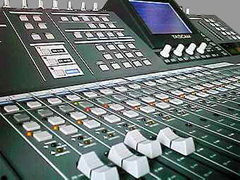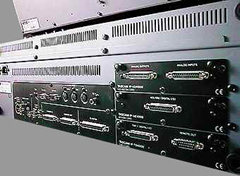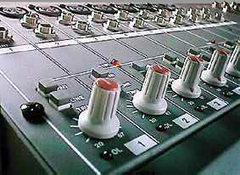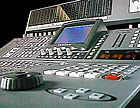| |
| INTRODUCTION |
 |
 |
The
Tascam TM-D4000 features the same user-friendly and well established
operative system yet available in the previous top model TM-D8000.
Anyway, some improvements have been implemented in order to provide
new interesting features, such as 24-bit input/output converters,motorized
faders and expansion cards.
The TM-D4000 is also very interesting under the point of view of
the quality/price ratio.
 Technical
Details Technical
Details
 Software Software
|
| MAIN
PLUS |
 |
 |
Flexibility.
The mixer provides 32 input channels. A card modular architecture
assures a total compatibility with the main I /O audio formats:
balanced analog and AES/EBU, T-DIF and Adat Optical digital formats.
8 outputs groups are available. Moreover, the first 16 channels
provide a direct output for a multitrack recorder: this feature
allows to work with up to three 8 tracks multitrack recorders simultaneously.
The TM-D4000 also provides 6 cut (mute) sub-groups and 6 levels
sub-groups.
Cascade inputs and outputs allow to connect up to four units together,
in order to increase the number of the available channels.
Automation. Automatic functions are not directly available
on the console, but the parameters can be controlled thru a Win95/98-based
supplied software.
The mixer and the computer can communicate thru the Host port and
a RS-422 board, included in the price, that should be installed
into the computer. TM-D4000 can also be totally automated via MIDI
through an external sequencer. This feature was not available in
the model TM-D8000.
It is also possible to save all the parameters settings into a specific
Snapshots library (scene memory), independent from the dynamics,
effects and EQ libraries.
Compact size. The carriage is very easy, due to the width
(only 64 cm.) and the weight (20 Kg.). This is surely useful in
case of live performances.
Competitive Q/P ratio. The mixer price is really convenient,
considering that the Meter Bridge and the automation software are
included in the packaging too.
A series of optional expansion cards are also available for advanced
users as well as the 25-pin digital cascade cables that allow the
connection of up to four TM-D4000.
|
| ARCHITECTURE |
 |
 |
DM-24
control surface is divided in different areas including fader control,
channel module, transport control, graphic display, function control
and monitor control.
17
motorized faders are available: 16 assignable faders (3 different
layer status can be selected in order to control channel 1-16, channel
17-32 or Bus/Aux Master levels) and 1 master fader. In addition,
faders can be used also for channel Aux send levels or channel Delay
time control.
All
channels are equipped with 4-bands Parametric EQ (Shelving, Peaking,
Notch, HPF/LPF modes available depending on the selected band),
Dynamic Processor and 6 Aux send. The Dynamic Processor works as
Compressor, while Gate functions are also available on channels
1-16.
In short, the unit is more powerful and in the same time more intuitive
and pleasant to use than the previous model.
Moreover, the availability of built-in digital ports and the possibility
to connect an optional CD mastering unit allows a fast and not too
expensive data back-up and CD mastering functions. |
| MIXER
FUNCTIONS AND CONCLUSIONS |
 |
| |
TM-D4000
provides a wide range of drivers for communication with audio recorders,
videorecorders, Direct-to-disk systems, effect processors and MIDI
devices.
The two built-in digital inputs can be both input channels or effects
return. Three Sourround modes can be selected (including the 5.1
mode) and controlled in real time by Pod.
In case of cascade connection, groups and aux send can be freely
assigned to the other consoles. A 371.5 ms @ 44.1 kHz sampling frequency
delay can be assigned to the output groups.
Talkback is built-in as well as an headphone connector. Audio source
select is very flexible. Timecode is shown on a wide LED display.
The current automation software release (1.1) is really user-friendly.
Nevertheless, the lack of some important functions should be pointed
out: the off-line editing (automix event list) and the cascade units
management. The minimum automation software requirement includes
a 15" monitor and a 32Mb RAM-equipped computer with 200MHz MMX processor.
The TM-D4000 flexibility assures a wide range of applications. Anyway,
the unit is expecially oriented to the audio/video post-production.
|
|
 |



